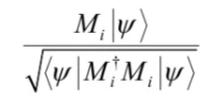-
量子计算(八):观测量和计算基下的测量

文章目录
观测量和计算基下的测量

一、观测量
量子比特(qubit)不同于经典的比特(bit),一个量子比特|
ψ " role="presentation" style="position: relative;">>可以同时处于|0>和|1>两个状态,可用线性代数中的线性组合(linear combination)来表示为
在量子力学中常称量子比特|
ψ " role="presentation" style="position: relative;">>处于|0>和|1>的叠加态(superpositions),其中α " role="presentation" style="position: relative;">、β " role="presentation" style="position: relative;">都是复数(complex number),两维复向量空间的一组标准正交基(orthonormal basis)|0>和|1>组成一组计算基(computational basis)。量子比特的信息不能直接获取,而是通过测量来获取量子比特的可观测的信息。可观测量在量子理论中由自伴算子(self-adjoint operators)来表征,自伴的有时也称Hermitian。量子理论中的可观测量与经典力学中的动力学量,如位置、动量和角动量等对应,而系统的其他特征,如质量或电荷,并不在可观测量的类别之中,它是作为参数被引入到系统的哈密顿量(Hamiltonian)。
在量子力学中测量(measure)会导坍塌,即是说测量会影响到原来的量子状态,因此量子状态的全部信息不可能通过一次测量得到。当对量子比特进行测量时,仅能得到该量子比特概率
| α | 2 | β | 2 | α | 2 + | β | 2 = 1 " role="presentation" style="position: relative;">。当对量子进行测量时,会发生什么变化呢?
假设:量子测量是由测量算子(measurement operators)的集合
{ M i } ( i n d e x ) i ψ " role="presentation" style="position: relative;">>,那么结果 发生的概率为
发生的概率为
并且测量后的系统状态变为

由于所有可能情况的概率和为1,即

因此,测量算子需满足

该方程被称为完备性方程(completeness equation)。
二、计算基下的测量
在计算基下单量子比特的测量,单量子比特在计算基下有两个测量算子分别是
 。注意到这两个测量算子都是自伴的,即
。注意到这两个测量算子都是自伴的,即
且

因此

该测量算子满足完备性方程。
设系统被测量时的状态是
 ,则测量结果为0的概率为
,则测量结果为0的概率为
对应测量后的状态为

测量结果为1的概率为

测量后的状态为

量子测量有很多种方式,比如投影测量(projective measurements)、POVM 测量(Positive Operator-Valued Measure)。
三、投影测量
为什么要介绍投影测量呢?因为当测量算子具有酉变换性质时,投影测量和一般测量等价。
投影测量由一个可观测量(observable)
Λ " role="presentation" style="position: relative;">来描述,可观测量Λ " role="presentation" style="position: relative;">是一个待观测系统的状态空间上的自伴算子。可观测量Λ " role="presentation" style="position: relative;">可以写成谱分解的形式
这里的
P i Λ " role="presentation" style="position: relative;">的特征值λ i Λ " role="presentation" style="position: relative;">的特征值λ i ψ " role="presentation" style="position: relative;">>测量之后,得到结果 的概率为
的概率为
若测量后,结果
 发生,则量子系统最新的状态为
发生,则量子系统最新的状态为 
投影测量有一个重要的特征就是很容易计算投影测量的平均值
E ( Λ ) " role="presentation" style="position: relative;">。
这个公式它能够简化很多计算。观测量
Λ " role="presentation" style="position: relative;">的平均值通常也记作 。因此,观测量
。因此,观测量Λ " role="presentation" style="position: relative;">的标准差(standard deviation)Δ ( Λ ) " role="presentation" style="position: relative;">满足
标准差是一个刻画典型分散程度的度量。
- 📢博客主页:https://lansonli.blog.csdn.net
- 📢欢迎点赞 👍 收藏 ⭐留言 📝 如有错误敬请指正!
- 📢本文由 Lansonli 原创,首发于 CSDN博客🙉
- 📢停下休息的时候不要忘了别人还在奔跑,希望大家抓紧时间学习,全力奔赴更美好的生活✨
-
相关阅读:
软件设计文档示例模板 - 学习/实践
基于Springboot外卖系统13:实现文件上传下载模块
大厂面试-美团高频考察算法之重排链表
0046_正点原子
国标视频云服务EasyGBS国标视频平台迁移服务器后无法启动的问题解决方法
kube-proxy参数ClusterCIDR做什么
(18)Verilog实现信号延迟N拍【4拍】
如何使用 Delphi/Lazarus 代码在 FastReport VCL 中生成二维码?
网站渗透总结之Getshell用法大全
代码坏味道
- 原文地址:https://blog.csdn.net/xiaoweite1/article/details/128005060